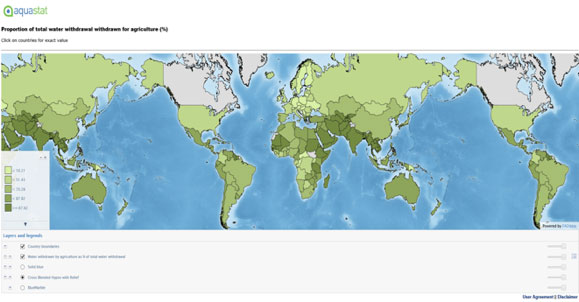Livestock is using 1/3 of all water resources in the world! - is this true?
Its true meaning and the methodology used to calculate this figure remains unknown, this is why it is essential to first understand the concept of the “water footprint” to estimate the real impact of livestock. Livestock is using one third of all water resource when one include, green, grey and blue water (see previous question).
When considering average livestock water consumption, more than 90% is green water (rainfall) captured in the soil and evaporated by the plants and which returns to the water cycle. This would happen with or without farm animals.Considering blue and grey water, that could enter in competition with fresh water consumption, it is estimated that livestock industries consume 13% of the global water supply, with most of that water being used for intensive, feed-based production.
The underlying question behind this is actually the issue of a potential competition of use of water resource between livestock production and other human activities.
Fresh water is a scarce resource worldwide
The world contains an estimated 1,400 million cubic km of water. However “fresh water resources” are limited. Only 2.5% of all water resources are fresh water[ref]Food and Agriculture Organization of the United Nations (FAO). 2006. Livestock’s Long Shadow: Environmental Issues and Options.[/ref] and only 0.003% of this vast amount, about 45 000 cubic km, could be used for drinking, hygiene, agriculture and industry (the rest being locked up in glaciers, permanent snow or in the atmosphere). Moreover, not all of this water is accessible because part of it flows into remote rivers during seasonal floods for instance. (FAO, 2017).

Global water demand is expected to increase greatly in the future, by 50% between 1995 and 2025 (United Nations Environment Programme, 2008), especially in developing countries, not only because of larger human populations, but also because of overall increases in industrial production and human affluence, which leads to greater consumption of energy, consumer goods, and food, especially animal products. This increase in domestic, industrial, and agricultural water use is expected to expand the areas affected by water scarcity[ref]Water use by livestock: A global perspective for a regional issue? Animal Frontiers, Volume 2, Issue 2, April 2012, Pages 9–16,[/ref].
Livestock production and water scarcity should be assessed at local level
There is not a global water shortage as such, but at individual countries and regions level the problem of water scarcity would need to be tackled. No evidence exists that the presence of livestock is related to the risk of water scarcity; for example, in France there is little overlap between regions with high livestock density and those with water-availability problems in summer, some of the latter being areas with irrigated crops.

Global models need to be assessed with care
Global models are in the early stages of development and do not distinguish between developing and developed countries, or the production systems within them. In some regions, especially developing countries, animals are not used solely for food production but also to provide draught power, fibre and fertiliser for crops. The multiple dimensions of livestock production are not accounted for when considering the water consumption per kilo of product.
In addition, animals make use of crop by-products that would otherwise go to waste. Water usage for livestock production should be considered an integral part of agricultural water resource management, taking into account the type of production system (e.g. grain-fed or mixed crop-livestock) and scale (intensive or extensive), the species and breeds of livestock, and the social and cultural aspects of livestock farming in various countries.

Improved farming practices could help to reduce livestock’s footprint
In Europe, limited margin exists when considering an improvement of direct water consumption by the livestock sector, as systems are already well optimised. For ruminants, total water intake is generally between 3.5 and 5.5 L/kg of dry matter intake. The greater the water content of feed, the less drinking water they require. For example, when early-stage fresh grass is fed, animals do not require drinking water. Increasing the proportion of fresh grass or silage in the diet thus decreases drinking water intake. (Source: https://academic.oup.com/af/article/2/2/9/4638620)
The main room for improvement to avoid local water shortage risks lies in the decrease of irrigated feeds. In this direction, a number of options exist ranging from the use of plants requiring less water or selected for their improved genetics to the enforcement of agronomic practices in fields by farmer feed producers.
Livestock can also have positive influences on water resources, for example, animal use of marshes damages biodiversity less than draining marshes to convert them to agriculture.
Sources:
– https://www.sciencedirect.com/science/article/pii/S2212371713000024
– Food and Agriculture Organization of the United Nations (FAO). 2006. Livestock’s Long Shadow: Environmental Issues and Options.
– https://www.researchgate.net/publication/49825039_Water_requirements_for_livestock_production_A_global_perspective